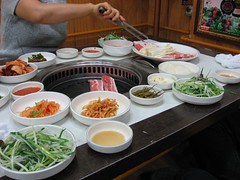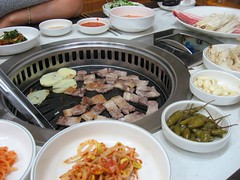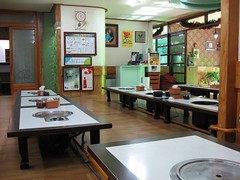 Due to an overestimation of my level of enthusiasm for a style of food Koreans call '쌈' (ssam), which I was introduced to at the Gyeongju 'pension', Korean Mother and wife took me to a meat ('삼겹살') restaurant for lunch, where the food was eaten in the 'ssam' style. Personally, I'd consider this a 'ssam restaurant' then, but that's not what they're called.
Due to an overestimation of my level of enthusiasm for a style of food Koreans call '쌈' (ssam), which I was introduced to at the Gyeongju 'pension', Korean Mother and wife took me to a meat ('삼겹살') restaurant for lunch, where the food was eaten in the 'ssam' style. Personally, I'd consider this a 'ssam restaurant' then, but that's not what they're called.The first task when entering this traditional Korean type restaurant is of course, to remove one's shoes in the entrance. The second, and equally important task in this particular restaurant, is to avoid tripping over the gas pipes which run across the floor to the tables. No, they'd never get away with it in the UK.
Within a few moments of sitting down, a large array of side dishes, along with a plate of meat, were delivered to our table. The lid in the centre was lifted to reveal the barbecue pit and the gas was turned on from a control at the side. Korean Mother then very professionally proceeded to start cooking the meat. Apparently, it's normally the women who cook at these restaurants, rather than the men, unlike in Haeundae on New Year's Eve when the men tackled the barbecue while the women were cooking other dishes in the kitchen. Suddenly, a new context is possibly placed on their struggle that night.
As the 'ssam' consumption progressed, I realised that while I might have enjoyed it in the freezing cold of a January evening after a long day of temple raids, it's not quite as appealing a couple of hours after eating Korean breakfast cereal. It wasn't that I didn't like it, but I kept thinking of mandu rather longingly. It's possible that my taste buds were somewhat stunned by my adventurous (i.e. blissfully ignorant) decision to start eating a leek dish ('파채') next to me which turned out to be so unexpectedly spicy I felt my nose starting to run. I didn't get very far with that.
Aside from not tripping over the gas pipes, another important lesson is not to wear anything too nice to this kind of restaurant if you plan on sitting anywhere near the actual barbecue, because those random pops and splashes from the barbecue pit are going to end up finding you. I also found that towards the end of the meal, my eyes were watering from the constant exposure to admittedly low-level of smoke rising from the cooking pit.
Total cost for three people - 16,000 won (about £8.77) - which seems really good value, especially since you can get free refills on each of the vegetable dishes.



6 comments:
I think the leek dish is actually just sliced green onion with a spicy dressing. You usually eat that with your ssam.
Korean family is sure that the dish we had was leek rather than green onion, even though some dictionaries translate 파채 as based on green onion.
However, '파' can mean leek, spring onion or green onion according to Naver with '채' meaning shredded. So perhaps there's some interpretation within different restaurants to what they actually make the dish with?
It might be a difference in Western "leeks" vs. what Korean's call it. I found one recipe that talks about leeks but they look more like Korean chives etc.
http://www.agrotrade.net/co/young/GC00008596/CA00008598/LEEK_PANCAKE_MIX_(Buchu_Jeon).html
Here's the agrotrade link (Blogger comment chopping strikes again).
This is a picture of what we ate.
Vegetable names confuse me anyway - for example there are quite a few differences between the names of the same vegetables in the UK and the US (and of course, Korea uses US English on the whole).
Post a Comment